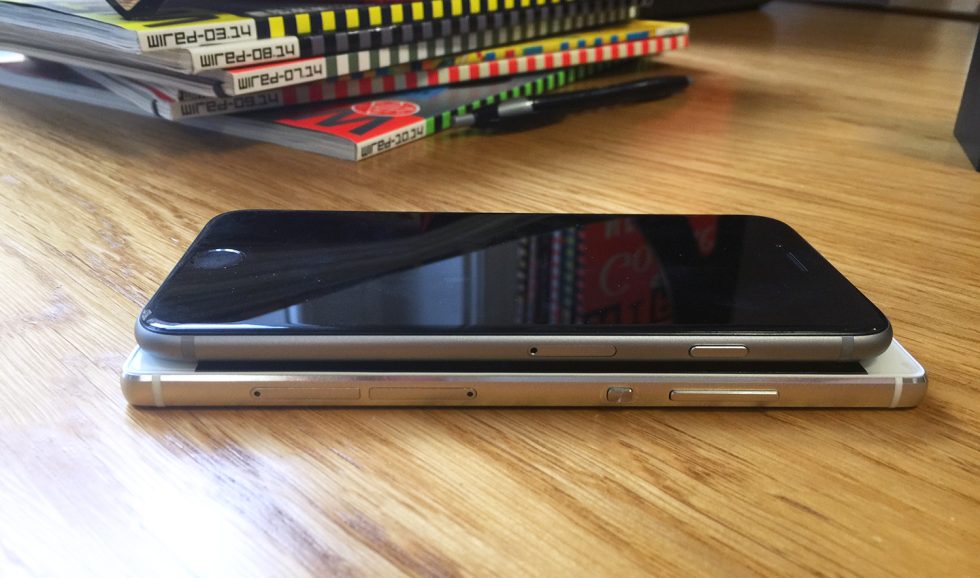
LONDON—After a few forays and false starts into the Western smartphone market over the past three years, the Chinese networking giant Huawei is back again with its third and most intriguing attempt yet: the P8.
To give you some idea of how much effort Huawei has put into its new flagship smartphone, the presentation in London lasted more than 90 minutes. Rather than run through a complete list of the P8's features, we'll start with the hardware specs and then drill down on what appear to be the core features: design, cameras, and usability.
Inside the P8, there's Huawei's own octa-core 64-bit Kirin 930 SoC, with four high-clocked (2GHz) Cortex-A53s paired with four low-clocked (1.5GHz) Cortex-A53s in a big.LITTLE arrangement. There's a Mali-T628 MP4 GPU, 3GB of RAM, a 2680 mAh battery, and a 5.2-inch 1080p screen. The phone has two SIM card slots (both supporting LTE), with one slot doubling up as a hybrid nano SD card slot.
Design-wise, Huawei says the P8 is thinner (6.4 mm) than the iPhone 6 (6.9 mm)—but in my hand, the P8 feels a bit chunkier, probably because the edges aren't as rounded as the iPhone. The unibody aluminum chassis makes the P8 feel like a solid, high-end phone—but due to the large screen and the rectangular silhouette, it definitely feels like a big phone.

The largest segment of Huawei's presentation focused on the P8's cameras, with various slides showcasing how it purportedly outperforms the iPhone 6. The rear-facing camera uses a stabilized (OIS) 13-megapixel RGBW (red, green, blue, white) sensor; in theory, the use of a white pixel—i.e. a clear, unfiltered pixel instead of the usual RGGB Bayer filter—allows for much better low-light performance. Huawei didn't officially say who manufactured the fancy sensor, but one of the product demonstrators told me it was made by Sony; the same guy told me the camera on the front is a new 8-megapixel BSI sensor from Sony, too. In early testing, both cameras seem very good, but more extensive testing is required.
Probably the biggest part of the P8 value proposition, however—at least as Huawei tells it, anyway—is the software. Most notably, the P8 is running a rather dramatically altered skin of Android 5.0 that Huawei calls EMUI (Emotion UI). If you can see past that, though, there are some very cool features, especially in the new camera app. "Light painting" mode lets you easily take long exposures of car headlamps, fire, etc. "Director" mode lets three other Android smartphones connect to the P8 via Wi-Fi Direct, with software on the P8 allowing the director to pick which video stream to edit into a final video.
-
The event was surprisingly large.
-
In case you weren't sure, the P8 is targeted directly at the iPhone 6.
-
The Huawei P8, in hand.Sebastian Anthony
-
The P8 comes in some pretty snazzy packaging.Sebastian Anthony
-
The P8, side-on.Sebastian Anthony
-
The iPhone 6 and P8, side by side.Sebastian Anthony
-
An iPhone 6 stacked on top of the Huawei P8.Sebastian Anthony
And then there's "Beauty" mode. I could write a whole long-form cultural piece on Beauty mode. You start by taking a few photos of your face from various angles. You then use some sliders to adjust your desired eye size, skin tone, and face thinness. Then, whenever you take a selfie, the P8 automatically applies your beautification preset. I'm not joking. It actually works quite well. I'm going to start uploading photos to Instagram with slightly larger eyes and an elfin chin to see if anyone notices.
There's also a slew of other new features that sound really cool, but we won't get unduly excited before we can test them properly. "Rich touch" means the display's digitizer can now tell the difference between your fingers and your knuckles, allowing you to do some new knuckle-based gestures. "Loud voice mode" lets you turn the volume to 11 if you're somewhere with lots of background noise. Some new tech allows the P8 to (apparently) connect to cellular networks "three times faster" than other phones; useful, if you roam a lot. If you use headphones with a single microphone—while jogging, say—there's apparently a new signal processing algorithm that provides "90% wind noise reduction."
The P8 is available in the UK, Europe, China, and a bunch of other countries today, starting at €499 (~$530). The P8 will come to the United States, but not for another month or two, and pricing wasn't announced. At the end of the event, Huawei also unveiled the P8 Max—a giant 6.8-inch version of the P8 with a monstrous 4,360 mAh battery—starting at €549 (~$590). Both the P8 and P8 Max will come in a range of colors—silver, gray, black, and gold—with the black and gold options reserved for "premium" models that cost €100 more, but which also come with 64GB of storage instead of 16GB.
reader comments
86